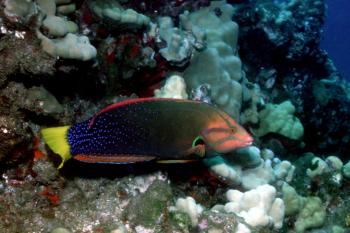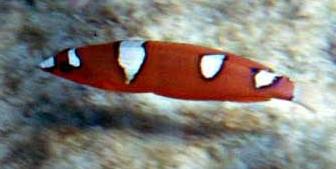Red Coris Wrasse (Yellow-tail Coris, Clown Coris)

Adult Yellow-Tail Coris Wrasse
Red coris wrasses (Coris gaimard) are colorful marine fish from the Indo-Pacific. They are commonly found off the coast of Hawaii. Like the other wrasses, they belong to the family Labridae.
The red coris wrasse is also commonly called the yellow-tail coris or the clown wrasse.
Red coris wrasses grow quite large for aquarium fish, reaching an adult size of about 14-16 inches (36-41 cm). Due to their large size you will need to provide them with a spacious aquarium (at least 90-100 gallons (341-379 liters)).
As in several other species of saltwater fish, juvenile yellow-tail coris look much different than the adults. Juveniles are orange with white spots that are outlined in black. As they mature they take on the adult coloration as shown in the top photo.

Juvenile Yellow-Tail Coris Wrasse
In their natural habitat red coris wrasses are found along coral reefs where they feed on invertebrates. They are active feeders and at night these wrasses bury themselves in the sand. So don't be alarmed if your red coris wrasse buries itself - this is normal behavior for them.
Because of this behavior, you will need to provide them with 3-5 inches of sand in their aquarium. You must use sand as the substrate in their tank, otherwise they will injure themselves while burying themselves. You should also provide other rockwork for caves in their tank.
They don't make good reef fish because they normally feed in reef invertebrates. This means they will eat your ornamental shrimps, crabs, and molluscs. In captivity they need to be fed a variety of meaty foods - chopped seafood, marine aquarium fare for carnivores, mysis shrimp, ect. They have large appetites, especially as juveniles, and need to be fed often.
Due to their large size, red coris wrasses shouldn't be kept with small fish, but in general, they aren't particularly aggressive toward their tankmates.
These fish are usually purchased as juveniles. As they grow larger they often move the rockwork and damage corals in their tank.
The red coris wrasse is a beautiful marine fish, however, I'm not certain that it should be kept in captivity, especially by inexperienced saltwater aquarists. I did an Internet search and there are several online marine fish retailers that don't even guarantee its live arrival. This is because these fish don't ship well and are difficult to maintain and keep alive in captivity. If you do decide to keep one, it is best to buy it locally rather than having it shipped to you across the country.
In my opinion, it is always best to leave marine fish in their natural habitat if they are known to have a poor survival rate in captivity. It is best to let public aquariums keep these fish and learn more about how to keep them alive in captivity before aquarists attempt to keep them in their tanks at home.
However, some aquarists do successfully keep red coris wrasses alive in their tanks, but they certainly aren't fish for saltwater aquarists who are new to marine fish keeping.
